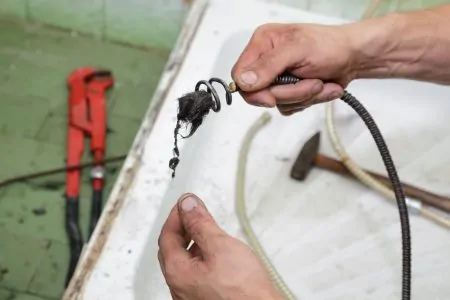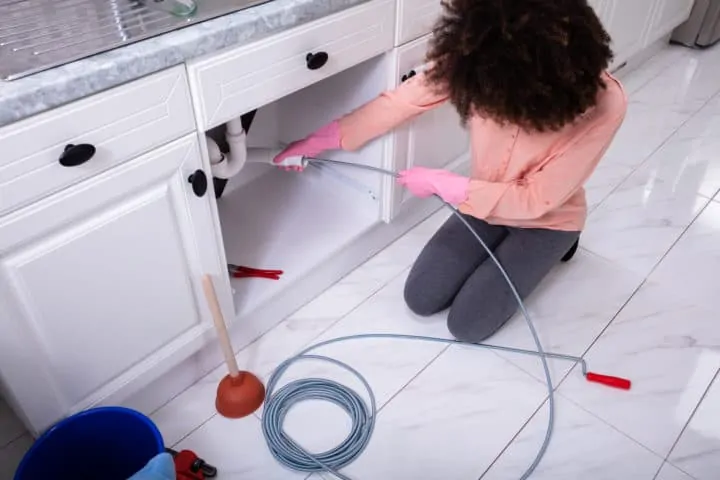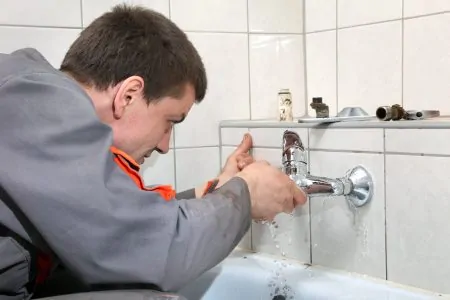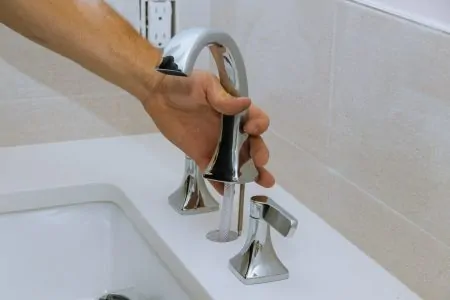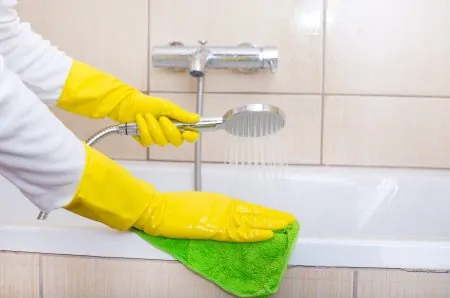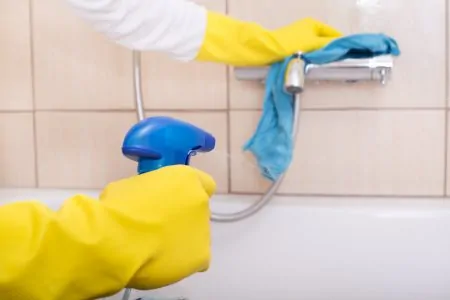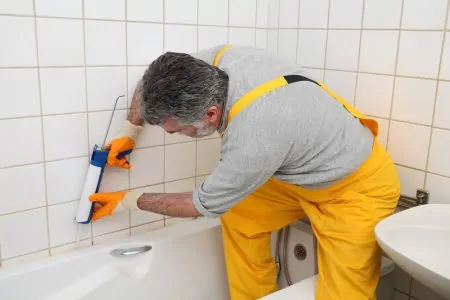A clogged bathtub drain is annoying, but it can also be unhygienic. The longer that water is in your bathtub, the more time soap, dirt, and other grime will have to attach themselves to the surface of the tub.
If water is draining from your bathtub slowly, or not at all, there are multiple ways to unblock your drain. Which option is best for you will depend on the type of blockage and your drain itself.
In this article, we will explain how to unclog a bathtub drain using three different approaches. These will ensure that water drains from your bath as intended, keeping your bathroom cleaner and more hygienic
Key Takeaways
- Use a drain claw to remove blockages close to the strainer by inserting it deep into the drain and pulling out debris.
- Chemical cleaners like sodium hypochlorite and sodium hydroxide can unclog drains but wear protective gear and ventilate the room when using them.
- Home remedies like baking soda and vinegar, tweezers, a plunger, or hot water and borax can help remove minor clogs without chemicals.
- Prevent future clogs by regularly cleaning the stopper and strainer and flushing the drain with boiling water weekly.
The best way to unclog a bathtub drain largely depends on where the clog is located. If the issue is close to the strainer, it can be removed easily. However, if the clog is further into the drain or plumbing, you will need specialized tools, such as a drain claw or snake.
Unclogging the Drain with a Drain Claw
A drain claw is a flexible wire with an auger on one end. The auger has multiple interlocking hooks that will attach to substances in the pipes. It is very flexible, so it can move deep into the plumbing past traps and bends.
Follow these steps to unclog your drain using a drain claw:
1. Remove the Strainer
A strainer is meant to catch large substances to prevent clogs, but some substances might still get past it. Soap and hair are commonly found beyond the strainer, either of which can cause trouble.
You might need to loosen a screw first. Find an appropriate screwdriver and turn the screw counterclockwise to remove it. Otherwise, you can go ahead and lift it out.
2. Take out the Stopper
The stopper is a little further into the drain — it is usually installed immediately below the strainer, or instead of it. Stoppers are easy to remove as there won’t be any screws. All you need to do is twist and lift.
Gunk and grime often accumulate around the drain stopper and strainer; this will cause clogging over time. Clean both parts using a sponge, cloth, or small brush.
3. Insert the Claw
The drain claw can reach far into the drain. When you hit the curved drain trap, keep pushing the claw through to achieve a thorough clean.
When you pull the claw out, the small interlocking hooks will bring anything that might be clogging the drain. Try to clean the hooks as thoroughly as you can, so you won’t transfer dirt back into your pipes next time you use the claw.
4. Test the Drain
After removing as much debris as possible, it’s time to test your drain and see if it’s clear. Open the faucet and see whether or not the water runs down the drain smoothly. If there are still signs of a blockage, try again or use one of the other methods below.
Place the stopper back into the drain by pushing and twisting it into place. Insert the strainer and reattach the screws if necessary.
Unclogging the Drain Using Chemicals
Chemical cleaners can be found in local stores and at online retailers such as Amazon and Home Depot. They are highly effective at unclogging drains but they can also release toxic fumes, so make sure you keep the room well-ventilated while using them.
Two of the most commonly-used chemicals are sodium hypochlorite and sodium hydroxide. They are very effective but can be toxic if mixed with other compounds such as ammonia. If you use a product containing these chemicals, wear protective gear and keep the room ventilated.
One of the leading chemical cleaners is Drano Max Gel. It is highly effective and can be used in sinks and bathtubs, with PVC or metal pipes.
When choosing a bathtub clog remover, ensure it is safe for your home’s plumbing. It should describe everything you need to know on its label.
1. Read the Instructions
When using chemical cleaners, it is essential that you follow the instructions carefully. Some cleaners will require that you wear protective gear, such as goggles and gloves. Certain cleaners only require a small amount of formula to be effective, while others will only clean properly in larger volumes.
2. Remove Standing Water
If your bathtub refuses to empty after a bath or shower, you will need to remove the water manually. This means grabbing a bucket, jug, or cup. Scoop out the water until the tub is empty.
3. Use the Required Amount of Product
Once you are properly protected with gloves and goggles, pour the required amount of cleaning fluid into and around the drain.
Be careful not to spill the product as you pour it. If you do spill it, wipe it up immediately to avoid any stains or damage.
Wait for the product to work its magic. Some will need 15 to 30 minutes while others require longer. Remember to follow the product’s instructions to ensure you leave it for the optimal amount of time. It is worth setting a timer if you do other things while waiting.
4. Flush with Cold Water
When enough time has passed, flush the bath and drain with cold water. Watch closely as the water enters the bathtub’s drain.
If it is still clogged, there could be a more significant issue than grime and hair. If the cleaner appears to have made little or no difference, you might need to call a professional plumber to find the cause of the problem.
Take Note
Unclogging the Drain Using Home Remedies
If you prefer not to use potentially hazardous chemicals, there are some excellent home remedies you can try:
Method #1: Baking Soda and Vinegar
This is the most reliable natural method without tools such as a drain snake or plunger. You only need some boiling water, baking soda, and vinegar. It should help you clear minor blockages.
- Remove and clean: Start by removing and cleaning the stopper and strainer. Clean them thoroughly to remove any grime and hair.
- Add cleaner: Pour 4 ounces of vinegar and 4 ounces of baking soda directly down the drain. Leave them to work for five minutes — it is worth setting a timer.
- Boiling water: Fill a kettle with water and boil it. After five minutes have passed, pour the boiling water down the drain; it will react with the vinegar and sodium bicarbonate (2).
Method #2: Tweezers
Using tweezers to clean a drain might sound time-consuming, but it can be very effective:
- Get ready: Remove the strainer and stopper.
- Tweezer action: Use the tweezers to extract any clumps of hair that are clogging your drain.
It’s that simple! This method is best used for clearing visible blockages that are within arm’s reach.
Method #3: Plunger
Plungers are very effective at dislodging clogs from drains. There are specific models for sinks and bathtubs; sink plungers are usually smaller than toilet plungers.
- Add water: Fill the tub slightly; the plunger will need a few inches of water depth to achieve the necessary suction.
- Plunge away: Place the plunger directly over the drain. Then, repeatedly press it down and release the pressure. Gunk and dirty water might rush out of the drain, so be careful not to get splashed.
If the plunger doesn’t seem to affect the blockage, try plunging with greater force. You can also attempt one of our other methods — if plunging has no effect, vinegar and baking soda might soften whatever is blocking your drain.
Be Cautious
Method #4: Hot Water and Borax
Take Care
Borax is used for many applications such as cleaning bathtubs and windows. It is also very useful when unclogging a drain. This is because it converts water molecules into hydrogen peroxide (4).
Here is our recommended method:
- Gain access: Use a screwdriver to remove the strainer and stopper.
- Add borax: Using a funnel, pour 4 ounces of borax down the drain.
- Combine with water: Slowly pour two cups of boiling water down the drain.
- Wait: Allow the mixture to work for 15 minutes.
- Rinse: Flush the tub and drain with cold water.
- Repeat: You might need to repeat the process if the blockage is stubborn.
Keeping the Drain Clear
Regularly cleaning the stopper and strainer is the best way to prevent your drain from getting blocked. Hair and soap scum will accumulate between these parts, which is the most common cause of clogging.
Remove the two parts and give them a thorough scrub and rinse with water. You can also use vinegar if there is any stubborn grime in the strainer or stopper.
Flush the drain using boiling water once each week. Boiling water will be enough to instantly dissolve most small clogs.
Be Careful
Replace the strainer and stopper, then test your drain. Fill the tub slightly to see how quickly water drains out of it. If the bath appears to still be clogged, you might need to hire a professional plumber.
